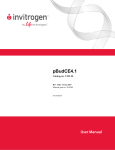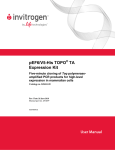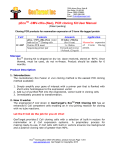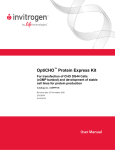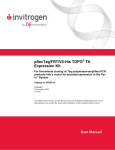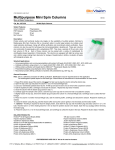Download Contents - Thermo Fisher Scientific
Transcript
pcDNA™3.1/V5-His A, B, and C Catalog no. V810-20 Rev. date: 09 November 2010 Manual part no. 28-0141 MAN0000645 Corporate Headquarters Invitrogen Corporation 1600 Faraday Avenue Carlsbad, CA 92008 T: 1 760 603 7200 F: 1 760 602 6500 E: [email protected] For country-specific contact information visit our web site at www.invitrogen.com User Manual ii Contents Contents and Storage ........................................................................................................................................... iv Methods ...................................................................................................................... 1 Cloning into pcDNA™3.1/V5-His A, B, and C ...................................................................................................1 Transformation and Transfection.........................................................................................................................6 Appendix..................................................................................................................... 9 pcDNA™3.1/V5-His A, B, and C Vectors............................................................................................................9 pcDNA™3.1/V5-His/lacZ....................................................................................................................................11 Accessory Products ..............................................................................................................................................12 Technical Support.................................................................................................................................................14 Purchaser Notification .........................................................................................................................................15 References..............................................................................................................................................................17 iii Contents and Storage Contents 20 μg each of pcDNA™3.1/V5-His A, B, and C are supplied at 0.5 μg/μl in 10 mM Tris-HCl, 1 mM EDTA, pH 8.0 in a total volume of 40 μl. 20 μg of pcDNA™3.1/V5-His/lacZ is supplied at 0.5 μg/μl in 10 mM Tris-HCl, 1 mM EDTA, pH 8.0 in a total volume of 40 μl. Shipping and Storage iv pcDNA™3.1/V5-His vectors are shipped on wet ice. Upon receipt, store vectors at –20ºC. Methods Cloning into pcDNA™3.1/V5-His A, B, and C Introduction pcDNA™3.1/V5-His A, B, and C are 5.5 kb vectors derived from pcDNA™3.1(+) and designed for high-level expression, purification, and detection of recombinant proteins in mammalian hosts. High-level stable and non-replicative transient expression can be carried out in most mammalian cells. The vectors contain the following elements: • Three reading frames to facilitate in-frame cloning with a C-terminal tag encoding the V5 epitope and a polyhistidine metal-binding peptide • Human cytomegalovirus (CMV) immediate-early promoter for high-level expression in a wide range of mammalian cells • Episomal replication in cell lines that are latently infected with SV40 or that express the SV40 large T antigen (e.g. COS7) The control plasmid, pcDNA™3.1/V5-His/lacZ, contains a 3.2 kb fragment containing the β-galactosidase gene cloned in frame with the C-terminal peptide (see page 11). pcDNA™3.1/V5-His/lacZ is included for use as a positive control for transfection, expression, purification, and detection in the cell line of choice. Experimental Outline Use the following outline to clone and express your gene of interest in pcDNA™3.1/V5-His. • • • • • • • Consult the multiple cloning sites described on pages 3–5 to determine which vector (A, B, or C) should be used to clone your gene in frame with the C-terminal V5 epitope and polyhistidine tag. Ligate your insert into the appropriate vector and transform into E. coli. Select transformants with 50 to 100 μg/ml ampicillin. Analyze your transformants for the presence of insert by restriction digestion. Select a transformant with the correct restriction pattern and use sequencing to confirm that your gene is in frame with the C-terminal peptide. Transfect your construct into the cell line of choice using your own method of transfection. Test for expression of your recombinant gene by western blot analysis or functional assay. If you do not have an antibody to your protein, Invitrogen offers Anti-V5 antibodies or Anti-His(C-term) antibodies to detect your recombinant protein. See page 13 for ordering information. To purify your recombinant protein, you may use metal-chelating resin such as ProBond™. ProBond™ resin is available separately (see page 13 for ordering information). Continued on next page 1 Cloning into pcDNA™3.1/V5-His A, B, and C, Continued Before Starting Diagrams are provided on pages 3–5 to help you ligate your gene of interest in frame with the C-terminal peptide. General considerations are listed below for additional information. For information on transformation and transfection, see page 6. General Molecular Biology Techniques For help with DNA ligations, E. coli transformations, restriction enzyme analysis, purification of single-stranded DNA, DNA sequencing, and DNA biochemistry, please refer to Molecular Cloning: A Laboratory Manual (Sambrook et al., 1989) or Current Protocols in Molecular Biology (Ausubel et al., 1994). Maintaining pcDNA™3.1/V5-His Many E. coli strains are suitable for the growth of this vector. To propagate and maintain pcDNA™3.1/V5-His A,B, and C, use 10 ng of the vector to transform a recA (recombination deficient), endA (endonuclease A deficient) E. coli strain like TOP10, TOP10F’, DH5α™-T1R, DH10B™, or equivalent (see page 12 for ordering information). Select the transformants on LB plates containing 50 to 100 μg/ml ampicillin. For long-term storage, prepare a glycerol stock of your plasmid containing E. coli strain. Kozak Sequence for Mammalian Expression If you are recombining your entry clone with a destination vector for mammalian expression, your insert should contain a Kozak consensus sequence with an ATG initiation codon for proper initiation of translation (Kozak, 1987; Kozak, 1991; Kozak, 1990). An example of a Kozak consensus sequence is provided below. Other sequences are possible, but the G or A at position –3 and the G at position +4 (shown in bold) illustrates the most commonly occurring sequence with strong consensus. Replacing one of the two bases at these positions provides moderate consensus, while having neither results in weak consensus. The ATG initiation codon is shown underlined. (G/A)NNATGG Continued on next page 2 Cloning into pcDNA™3.1/V5-His A, B, and C, Continued Multiple Cloning Site of pcDNA™3.1/V5-His A Below is the multiple cloning site for pcDNA™3.1/V5-His A. Restriction sites are labeled to indicate the cleavage site. Note that there is a stop codon between the BamH I site and the BstX I site. The multiple cloning site has been confirmed by sequencing and functional testing. The sequence is available for downloading from www.invitrogen.com or by contacting Technical Support (see page 14). T7 promoter/priming site Hind III Kpn I 861 ATTAATACGA CTCACTATAG GGAGACCCAA GCTGGCTAGT TAA GCT TGG TAC CGA GCT Ala Trp Tyr Arg Ala BstX I* EcoR I EcoR V BstX I* Not I 922 ATC CAC TAG TCC AGT GTG GTG GAA TTC TGC AGA TAT CCA GCA CAG TGG CGG Ile His *** Ser Ser Val Val Glu Phe Cys Arg Tyr Pro Ala Gln Trp Arg V5 epitope Xho I Xba I Apa I Sfu I 976 CTC GAG TCT AGA GGG CCC TTC GAA GGT AAG CCT ATC CCT AAC CCT CTC CTC Leu Glu Ser Arg Gly Pro Phe Glu Gly Lys Pro Ile Pro Asn Pro Leu Leu Age I Polyhistidine tag Pme I 1030 CTC GAT TCT ACG CGT ACC GGT CAT CAT CAC CAT CAC CAT TGA GTTTAAACCC Leu Asp Ser Thr Arg Thr Gly His His His His His His *** BamH I CGG Arg CCG Pro GGT Gly BGH Reverse priming site 1083 GCTGATCAGC CTCGACTGTG CCTTCTAGTT GCCAGCCAT *Note that there are two BstX I sites in the polylinker. Continued on next page 3 Cloning into pcDNA™3.1/V5-His A, B, and C, Continued Multiple Cloning Site of pcDNA™3.1/V5-His B Below is the multiple cloning site for pcDNA™3.1/V5-His B. Restriction sites are labeled to indicate the cleavage site. The boxed nucleotides indicate the variable region. The multiple cloning site has been confirmed by sequencing and functional testing. The sequence is available for downloading from www.invitrogen.com or by contacting Technical Support (see page 14). T7 promoter/priming site Hind III Kpn I BamH I 861 ATTAATACGA CTCACTATAG GGAGACCCAA GCTGGCTAGT TAAG CTT GGT ACC GAG CTC GGA Leu Gly Thr Glu Leu Gly BstX I* EcoR I EcoR V BstX I* Not I ACT AGT CCA GTG TGG TGG AAT TCT GCA GAT ATC CAG CAC AGT GGC GGC CGC 923 TCC Ser Thr Ser Pro Val Trp Trp Asn Ser Ala Asp Ile Gln His Ser Gly Gly Arg V5 epitope Xho I Xba I Apa I Sac II Sfu I 977 TCG AGT CTA GAG GGC CCG CGG TTC GAA Ser Ser Leu Glu Gly Pro Arg Phe Glu Age I 1031 GGT CTC GAT TCT ACG CGT ACC GGT CAT Gly Leu Asp Ser Thr Arg Thr Gly His BGH Reverse priming site GGT AAG CCT ATC CCT AAC CCT CTC CTC Gly Lys Pro Ile Pro Asn Pro Leu Leu Polyhistidine tag Pme I CAT CAC CAT CAC CAT TGA GTTTA His His His His His *** 1081 AACCCGCTGA TCAGCCTCGA CTGTGCCTTC TAGTTGCCAG *Note that there are two BstX I sites in the polylinker. Continued on next page 4 Cloning into pcDNA™3.1/V5-His A, B, and C, Continued Multiple Cloning Site of pcDNA™3.1/V5-His C Below is the multiple cloning site for pcDNA™3.1/V5-His C. Restriction sites are labeled to indicate the cleavage site. The boxed nucleotides indicate the variable region. The multiple cloning site has been confirmed by sequencing and functional testing. The sequence is available for downloading from www.invitrogen.com or by contacting Technical Support (see page 14). T7 promoter/priming site Hind III Kpn I 861 ATTAATACGA CTCACTATAG GGAGACCCAA GCTGGCTAGT TA AGC TTG GTA CCG AGC Ser Leu Val Pro Ser BamH I BstX I* EcoR I EcoR V BstX I* 918 TCG GAT CCA CTA GTC CAG TGT GGT GGA ATT CTG CAG ATA TCC AGC ACA GTG Ser Asp Pro Leu Val Gln Cys Gly Gly Ile Leu Gln Ile Ser Ser Thr Val V5 epitope BstE II Xho I Sfu I Not I 969 GCG GCC GCT CGA GGT CAC CCA TTC GAA GGT AAG CCT ATC CCT AAC CCT CTC Ala Ala Ala Arg Gly His Pro Phe Glu Gly Lys Pro Ile Pro Asn Pro Leu Age I Polyhistidine tag 1020 CTC GGT CTC GAT TCT ACG CGT ACC GGT CAT CAT CAC CAT CAC CAT TGA GTT Leu Gly Leu Asp Ser Thr Arg Thr Gly His His His His His His *** BGH Reverse priming site Pme I 1071 TAAACCCGCT GATCAGCCTC GACTGTGCCT TCTAGTTGCC AGCCATCTGT *Note that there are two BstX I sites in the polylinker. 5 Transformation and Transfection E. coli Transformation Transform your ligation mixtures into a competent recA, endA E. coli strain (e.g., TOP10, TOP10F’, DH5α™-T1R, DH10B™, page 12) and select on LB plates containing 50–100 μg/ml ampicillin. Select 10–20 clones and analyze for the presence and orientation of your insert. Applying Selective We recommend taking some (if not all) of the following precautions to prevent your clone from being “overrun” by background contaminants: Pressure • Use carbenicillin instead of ampicillin. Carbenicillin is more stable than ampicillin, and allows for a longer period of selective pressure, thus preserving your clones longer. • Increase the antibiotic concentration. More antibiotic means that your clones will not be overwhelmed by β-lactamase buildup. Periodically refresh plate media. If you suspect that tubes/plates may be beginning to fail, spin them down, remove the old media, and replenish the wells with fresh LB media plus glycerol and antibiotic. • MEND ION AT RECOM Streak clones on selective (preferably carbenicillin) LB agar plates. After about 12 hours, isolate colonies for downstream usage. This will isolate your desired clones from potential background contaminants. We recommend that you sequence your construct with the T7 Promoter and BGH Reverse primers (see page 12 for ordering information) to confirm that your gene is fused in frame with the V5 epitope and the C-terminal polyhistidine tag. Refer to the diagrams on pages 3–5 for the sequence and location of the priming sites. Primer T7 Promoter BGH Reverse Sequence 5’-TAATACGACTCACTATAGGG-3’ 5’-TAGAAGGCACAGTCGAGG-3’ For your convenience, Invitrogen offers a custom primer service. For more information, visit www.invitrogen.com or call Technical Support (see page 14). Plasmid Preparation Plasmid DNA for transfection into eukaryotic cells must be very clean and free from phenol and sodium chloride. Contaminants will kill the cells and salt will interfere with lipid complexing, decreasing transfection efficiency. We recommend isolating DNA using the PureLink™ HiPure Miniprep Kit or the PureLink™ HiPure Midiprep Kit (see page 12 for ordering information) or CsCl gradient centrifugation. Continued on next page 6 Transformation and Transfection, Continued Methods of Transfection For established cell lines (e.g. HeLa), consult original references or the supplier of your cell line for the optimal method of transfection. Precisely follow the protocol for your cell line, paying particular attention to medium requirements, when to pass the cells, and at what dilution to split the cells. Further information is provided in Current Protocols in Molecular Biology (Ausubel et al., 1994). Methods for transfection include calcium phosphate (Chen and Okayama, 1987; Wigler et al., 1977), lipid-mediated (Felgner et al., 1989; Felgner and Ringold, 1989) and electroporation (Chu et al., 1987; Shigekawa and Dower, 1988). For high efficiency transfection in a broad range of mammalian cells, use Lipofectamine™ 2000 Reagent available from Invitrogen (see page 12). For more information on Lipofectamine™ 2000 and other transfection reagents, visit our web site at www.invitrogen.com or contact Technical Support (see page 14). Positive Control pcDNA™3.1/V5-His/lacZ is provided as a positive control vector for mammalian transfection and expression (see page 11). pcDNA™3.1/V5-His/lacZ may be used to optimize transfection conditions for your cell line. The gene encoding β-galactosidase is expressed in mammalian cells as a fusion protein (MW 121 kDa). A successful transfection results in β-galactosidase expression that can be easily assayed. Assay for β-galactosidase Activity You may assay for β-galactosidase expression by activity assay using cell-free lysates (Miller, 1972) or by staining the cells for activity. Invitrogen offers the β-Gal Assay Kit and the β-Gal Staining Kit (see page 12 for ordering information) for fast, easy detection of β-galactosidase expression. Detection of Fusion Proteins A number of antibodies are available from Invitrogen that can be used to detect expression of your fusion protein from pcDNA™3.1/V5-His (see page 13 for ordering information). The C-terminal tag adds about 3 kDa to the size of your protein. Additional amino acids may be added to your protein depending on the sites used to clone the gene of interest. Geneticin® Selective Antibiotic For stable transfection, pcDNA™3.1/V5-His A, B, and C contain the resistance factor to Geneticin®. Geneticin® blocks protein synthesis in mammalian cells by interfering with ribosomal function. It is an aminoglycoside, similar in structure to neomycin, gentamycin, and kanamycin. Expression in mammalian cells of the bacterial aminoglycoside phosphotransferase gene (APH), derived from Tn5, results in detoxification of Geneticin® Selective Antibiotic (Southern and Berg, 1982). Continued on next page 7 Transformation and Transfection, Continued Geneticin® Selection Guidelines Geneticin® is available from Invitrogen (see page 12 for ordering information). Use as follows: 1. Prepare Geneticin® in a buffered solution (e.g. 100 mM HEPES, pH 7.3). 2. Use 100 to 1,000 μg/ml of Geneticin® in complete medium. 3. Calculate concentration based on the amount of active drug (check the lot label). 4. Test varying concentrations of Geneticin® on your cell line to determine the concentration that kills your cells (kill curve). Cells differ in their susceptibility to Geneticin®. Cells will divide once or twice in the presence of lethal doses of Geneticin® Selective Antibiotic, so the effects of the drug take several days to become apparent. Complete selection can take from 2 to 4 weeks of growth in selective medium. Preparing Cells for Use the procedure below to prepare cells for lysis prior to purification of your protein on ProBond™ (see page 13). You will need 5 × 106 to 1 × 107 cells for Lysis purification of your protein on a 2 ml ProBond™ column (see ProBond™ Protein Purification manual). 1. 2. 3. 4. 5. Lysing of Cells 8 Seed cells in five T-75 flasks or 2 to 3 T-150 flasks. Grow the cells in selective medium until they are 80–90% confluent. Harvest the cells by treating with trypsin-EDTA for 2 to 5 minutes or by scraping the cells in PBS. Inactivate the trypsin, if necessary, and transfer the cells to a sterile microcentrifuge tube. Centrifuge the cells at approximately 250 × g for 5 minutes. You may lyse the cells immediately or freeze in liquid nitrogen and store at −80°C until needed. If you are using ProBond™ resin, refer to the ProBond™ Protein Purification manual for details about sample preparation for chromatography. If you are using other metal-chelating resin, refer to the manufacturer's instruction. Appendix pcDNA™3.1/V5-His A, B, and C Vectors The figure below summarizes the features of the pcDNA™3.1/V5-His vectors. The sequences for pcDNA™3.1/V5-His A, B, and C are available for downloading from www.invitrogen.com or by contacting Technical Support (see page 14). Details of the multiple cloning sites are shown on page 3 for pcDNA™3.1/V5-His A, page 4 for pcDNA™3.1/V5-His B, and page 5 for pcDNA™3.1/V5-His C. Hind III Kpn I BamH I BstX I EcoR I EcoR V BstX I Not I Xho I Xba I* Apa I** Sfu I V5 epitope T7 BGH pA V P CM 6xHis Term Pme I Age I Map of pcDNA™3.1/V5-His f1 or i ri 40 o SV N e o m yci n A m p i c i l li pcDNA3.1/ V5-His A, B, C 5.5 kb n Comments for pcDNA3.1/V5-His A: 5502 nucleotides p U C o ri CMV promoter: bases 209-863 T7 promoter/priming site: bases 863-882 Multiple cloning site: bases 902-999 V5 epitope: bases 1000-1041 Polyhistidine (6xHis) tag: bases 1051-1068 BGH reverse priming site: bases 1091-1108 BGH polyadenylation signal: bases 1090-1304 f1 origin of replication: bases 1357-1780 SV40 promoter and origin: bases 1845-2169 Neomycin resistance gene: bases 2205-2999 SV40 polyadenylation signal: bases 3018-3256 pUC origin: bases 3688-4361 (C) Ampicillin resistance gene: bases 4506-5366 (C) (C) = complementary strand 40 SV pA * After the Xho I site, there is a unique BstE II site, but no Xba I or Apa I sites in version C. ** There is a unique Sac II site between the Apa I site and the Sfu I site in version B only. Continued on next page 9 pcDNA™3.1/V5-His A, B, and C Vectors, Continued Features of pcDNA™3.1/ V5-His pcDNA™3.1/V5-His A (5,502 bp), pcDNA™3.1/V5-His B (5,506 bp), and pcDNA™3.1/ V5-His C (5,498 bp) contain the following elements. All features have been functionally tested. Feature 10 Benefit Human cytomegalovirus (CMV) immediate-early promoter/enhancer Permits efficient, high-level expression of your recombinant protein (Andersson et al., 1989; Boshart et al., 1985; Nelson et al., 1987). T7 promoter/priming site Allows for in vitro transcription in the sense orientation and sequencing through the insert. Multiple cloning site in three reading frames Allows insertion of your gene and facilitates cloning in frame with the V5 epitope and polyhistidine C-terminal tag. V5 epitope (Gly-Lys-Pro-Ile-Pro-Asn-ProLeu-Leu-Gly-Leu-Asp-SerThr) Allows detection of your recombinant protein with the Anti-V5 Antibody (Catalog no. R96025) and the Anti-V5-HRP Antibody (Catalog no. R961-25) (Southern et al., 1991). C-terminal polyhistidine tag Permits purification of your recombinant protein on metal-chelating resin such as ProBond™. In addition, the C-terminal polyhistidine tag is the epitope for the Anti-His (C-term) Antibody (Catalog no. R930-25) and the Anti-His (Cterm)-HRP Antibody (Catalog no. R931-25). BGH reverse priming site Permits sequencing through the insert. Bovine growth hormone (BGH) polyadenylation signal Efficient transcription termination and polyadenylation of mRNA (Goodwin and Rottman, 1992). f1 origin Allows rescue of single-stranded DNA. SV40 early promoter and origin Allows efficient, high-level expression of the neomycin resistance gene and episomal replication in cells expressing the SV40 large T antigen. Neomycin resistance gene Selection of stable transfectants in mammalian cells (Southern and Berg, 1982). SV40 polyadenylation signal Efficient transcription termination and polyadenylation of mRNA. pUC origin High-copy number replication and growth in E. coli. Ampicillin resistance gene (β-lactamase) Selection of vector in E. coli. pcDNA™3.1/V5-His/lacZ pcDNA™3.1/V5-His/lacZ is a 8,549 bp control vector containing the gene for β-galactosidase. pcDNA™3.1/V5-His C was digested with EcoR V and Not I. A 3.2 kb blunt-Not I fragment containing the β-galactosidase gene was then ligated into pcDNA™3.1/V5-His C in frame with the C-terminal peptide. Map of pcDNA™3.1/ V5-His/lacZ The figure below summarizes the features of the pcDNA™3.1/V5-His/lacZ vector. The nucleotide sequence for pcDNA™3.1/V5-His/lacZ is available for downloading from www.invitrogen.com or by contacting Technical Support (see page 14). V P CM BGH pA f1 Neo m y cin pcDNA3.1/ V5-His/lacZ 8.5 kb p U C or i Term or i n CMV promoter: bases 209-863 T7 promoter/priming site: bases 863-882 lacZ with C-terminal tag: 963-4115 lacZ ORF: bases 963-4019 V5 epitope: bases 4047-4088 Polyhistidine (6xHis) tag: bases 4098-4115 BGH reverse priming site: bases 4138-4155 BGH polyadenylation signal: bases 4137-4351 f1 origin of replication: bases 4414-4827 SV40 promoter and origin: bases 4892-5216 Neomycin resistance gene: bases 5252-6046 SV40 polyadenylation signal: bases 6065-6303 pUC origin: bases 6735-7408 (C) Ampicillin resistance gene: bases 7553-8413 (C) (C) = complementary strand 6xHis 0 ori SV4 A m p i c i l li Comments for pcDNA3.1/V5-His/lacZ: 8549 nucleotides lacZ Not I Xho I Sfu I T7 Hind III BamH I V5 epitope Pme I Age I Description 40 SV pA 11 Accessory Products Additional Products The following additional products may be used with the pcDNA™3.1/V5-His vectors. For more information, visit www.invitrogen.com or contact Technical Support (see page 14). Item One Shot TOP10 Chemically Competent E. coli One Shot® TOP10F´ Chemically Competent E. coli ® Cat. no. 10 reactions C4040-10 20 × 50 μl C3030-03 One Shot® Max Efficiency® DH5α™ T1R Competent Cells 20 × 50 μl 12297-016 Max Efficiency® DH10B™ Competent Cells 5 × 0.2 ml 18297-010 Electrocomp™ 2 × 20 reactions Kit C66511 Ampicillin 200 mg 11593-027 Carbenicillin 5g 10177-012 T7 promoter primer 2 μg N560-02 BGH Reverse primer 2 μg N575-02 PureLink HiPure Plasmid Miniprep Kit 100 preps K2100-03 PureLink™ HiPure Plasmid Midiprep Kit 25 preps K2100-04 Lipofectamine™ 2000 Reagent 1.5 ml 11668-019 β–Gal Assay Kit 1 kit K1455-01 β–Gal Staining Kit 1 kit K1465-01 ™ Geneticin® Selective Antibiotic Quantity For stable transfection, the pcDNA™3.1/V5-His vectors contain the resistance factor to Geneticin®. Geneticin® is available from Invitrogen. For more information, visit www.invitrogen.com or contact Technical Support (see page 14). Quantity Item ® Geneticin Selective Antibiotic Cat. no. 1g 11811-023 5g 11811-031 25 g 11811-098 20 ml (50 mg/ml) 10131-035 100 ml (50 mg/ml) 10131-027 Continued on next page 12 Accessory Products, Continued Detecting Fusion Proteins A number of antibodies are available from Invitrogen that can be used to detect expression of your fusion protein from pcDNA™3.1/V5-His. The table below describes the antibodies available and ordering information. The amount of antibody supplied is sufficient for 25 western blots. Antibody Anti-V5 Detects 14 amino acid epitope derived from the P and V proteins of the paramyxovirus, SV5 (Southern et al., 1991) Anti-V5-HRP Anti-V5-AP Anti-His(C-term) Anti-His(C-term)-HRP Anti-His(C-term)-AP Purifying Fusion Proteins Purpose Cat. no. R960-25 R961-25 R962-25 R930-25 Detects the C-terminal polyhistidine tag (requires the free R931-25 carboxyl group for detection) R932-25 The following products can be used in conjunction with pcDNA™3.1/V5-His vectors to purify recombinant protein. Item Quantity Cat. no. ™ 6 purifications K850-01 ™ 50 ml R801-01 150 ml R801-15 ProBond Purification System ProBond Nickel-Binding Resin (Precharged resin provided as a 50% slurry in 20% ethanol) 13 Technical Support Web Resources Contact Us Visit the Invitrogen website at www.invitrogen.com for: • Technical resources, including manuals, vector maps and sequences, application notes, MSDSs, FAQs, formulations, citations, handbooks, etc. • Complete technical support contact information • Access to the Invitrogen Online Catalog • Additional product information and special offers For more information or technical assistance, call, write, fax, or email. Additional international offices are listed on our website (www.invitrogen.com). Corporate Headquarters: 5791 Van Allen Way Carlsbad, CA 92008 USA Tel: 1 760 603 7200 Tel (Toll Free): 1 800 955 6288 Fax: 1 760 602 6500 E-mail: [email protected] Japanese Headquarters: LOOP-X Bldg. 6F 3-9-15, Kaigan Minato-ku, Tokyo 108-0022 Tel: 81 3 5730 6509 Fax: 81 3 5730 6519 E-mail: [email protected] European Headquarters: Inchinnan Business Park 3 Fountain Drive Paisley PA4 9RF, UK Tel: +44 (0) 141 814 6100 Tech Fax: +44 (0) 141 814 6117 E-mail: [email protected] MSDS Material Safety Data Sheets (MSDSs) are available on our website at www.invitrogen.com/msds. Certificate of Analysis The Certificate of Analysis provides detailed quality control and product qualification information for each product. Certificates of Analysis are available on our website. Go to www.invitrogen.com/support and search for the Certificate of Analysis by product lot number, which is printed on the box. Limited Warranty Invitrogen (a part of Life Technologies Corporation) is committed to providing our customers with high-quality goods and services. Our goal is to ensure that every customer is 100% satisfied with our products and our service. If you should have any questions or concerns about an Invitrogen product or service, contact our Technical Support Representatives. All Invitrogen products are warranted to perform according to specifications stated on the certificate of analysis. The Company will replace, free of charge, any product that does not meet those specifications. This warranty limits the Company’s liability to only the price of the product. No warranty is granted for products beyond their listed expiration date. No warranty is applicable unless all product components are stored in accordance with instructions. The Company reserves the right to select the method(s) used to analyze a product unless the Company agrees to a specified method in writing prior to acceptance of the order. Invitrogen makes every effort to ensure the accuracy of its publications, but realizes that the occasional typographical or other error is inevitable. Therefore the Company makes no warranty of any kind regarding the contents of any publications or documentation. If you discover an error in any of our publications, please report it to our Technical Support Representatives. Life Technologies Corporation shall have no responsibility or liability for any special, incidental, indirect or consequential loss or damage whatsoever. The above limited warranty is sole and exclusive. No other warranty is made, whether expressed or implied, including any warranty of merchantability or fitness for a particular purpose. 14 Purchaser Notification Limited Use Label License No. 5: Invitrogen Technology The purchase of this product conveys to the buyer the non-transferable right to use the purchased amount of the product and components of the product in research conducted by the buyer (whether the buyer is an academic or for-profit entity). The buyer cannot sell or otherwise transfer (a) this product (b) its components or (c) materials made using this product or its components to a third party or otherwise use this product or its components or materials made using this product or its components for Commercial Purposes. The buyer may transfer information or materials made through the use of this product to a scientific collaborator, provided that such transfer is not for any Commercial Purpose, and that such collaborator agrees in writing (a) not to transfer such materials to any third party, and (b) to use such transferred materials and/or information solely for research and not for Commercial Purposes. Commercial Purposes means any activity by a party for consideration and may include, but is not limited to: (1) use of the product or its components in manufacturing; (2) use of the product or its components to provide a service, information, or data; (3) use of the product or its components for therapeutic, diagnostic or prophylactic purposes; or (4) resale of the product or its components, whether or not such product or its components are resold for use in research. For products that are subject to multiple limited use label licenses, the terms of the most restrictive limited use label license shall control. Life Technologies Corporation will not assert a claim against the buyer of infringement of patents owned or controlled by Life Technologies Corporation which cover this product based upon the manufacture, use or sale of a therapeutic, clinical diagnostic, vaccine or prophylactic product developed in research by the buyer in which this product or its components was employed, provided that neither this product nor any of its components was used in the manufacture of such product. If the purchaser is not willing to accept the limitations of this limited use statement, Life Technologies is willing to accept return of the product with a full refund. For information about purchasing a license to use this product or the technology embedded in it for any use other than for research use please contact Out Licensing, Life Technologies, 5791 Van Allen Way, Carlsbad, California 92008; Phone (760) 603-7200 or e-mail: [email protected]. Limited Use Label License No. 22: Vectors and Clones Encoding Histidine Hexamer This product is licensed under U.S. Patent Nos. 5,284,933 and 5,310,663 and foreign equivalents from Hoffmann-LaRoche, Inc., Nutley, NJ and/or Hoffmann-LaRoche Ltd., Basel, Switzerland and is provided only for use in research. Information about licenses for commercial use is available from QIAGEN GmbH, Max-Volmer-Str. 4, D-40724 Hilden, Germany. 15 References Andersson, S., Davis, D. L., Dahlbäck, H., Jörnvall, H., and Russell, D. W. (1989). Cloning, Structure, and Expression of the Mitochondrial Cytochrome P-450 Sterol 26-Hydroxylase, a Bile Acid Biosynthetic Enzyme. J. Biol. Chem. 264, 8222-8229. Ausubel, F. M., Brent, R., Kingston, R. E., Moore, D. D., Seidman, J. G., Smith, J. A., and Struhl, K. (1994). Current Protocols in Molecular Biology (New York: Greene Publishing Associates and WileyInterscience). Boshart, M., Weber, F., Jahn, G., Dorsch-Häsler, K., Fleckenstein, B., and Schaffner, W. (1985). A Very Strong Enhancer is Located Upstream of an Immediate Early Gene of Human Cytomegalovirus. Cell 41, 521-530. Chen, C., and Okayama, H. (1987). High-Efficiency Transformation of Mammalian Cells by Plasmid DNA. Mol. Cell. Biol. 7, 2745-2752. Chu, G., Hayakawa, H., and Berg, P. (1987). Electroporation for the Efficient Transfection of Mammalian Cells with DNA. Nuc. Acids Res. 15, 1311-1326. Felgner, P. L., Holm, M., and Chan, H. (1989). Cationic Liposome Mediated Transfection. Proc. West. Pharmacol. Soc. 32, 115-121. Felgner, P. L., and Ringold, G. M. (1989). Cationic Liposome-Mediated Transfection. Nature 337, 387-388. Goodwin, E. C., and Rottman, F. M. (1992). The 3´-Flanking Sequence of the Bovine Growth Hormone Gene Contains Novel Elements Required for Efficient and Accurate Polyadenylation. J. Biol. Chem. 267, 16330-16334. Kozak, M. (1987). An Analysis of 5´-Noncoding Sequences from 699 Vertebrate Messenger RNAs. Nuc. Acids Res. 15, 8125-8148. Kozak, M. (1990). Downstream Secondary Structure Facilitates Recognition of Initiator Codons by Eukaryotic Ribosomes. Proc. Natl. Acad. Sci. USA 87, 8301-8305. Miller, J. H. (1972). Experiments in Molecular Genetics (Cold Spring Harbor, New York: Cold Spring Harbor Laboratory). Nelson, J. A., Reynolds-Kohler, C., and Smith, B. A. (1987). Negative and Positive Regulation by a Short Segment in the 5´-Flanking Region of the Human Cytomegalovirus Major Immediate-Early Gene. Mol. Cell. Biol. 7, 4125-4129. Sambrook, J., Fritsch, E. F., and Maniatis, T. (1989). Molecular Cloning: A Laboratory Manual, Second Edition (Plainview, New York: Cold Spring Harbor Laboratory Press). Shigekawa, K., and Dower, W. J. (1988). Electroporation of Eukaryotes and Prokaryotes: A General Approach to the Introduction of Macromolecules into Cells. BioTechniques 6, 742-751. Southern, J. A., Young, D. F., Heaney, F., Baumgartner, W., and Randall, R. E. (1991). Identification of an Epitope on the P and V Proteins of Simian Virus 5 That Distinguishes Between Two Isolates with Different Biological Characteristics. J. Gen. Virol. 72, 1551-1557. Southern, P. J., and Berg, P. (1982). Transformation of Mammalian Cells to Antibiotic Resistance with a Bacterial Gene Under Control of the SV40 Early Region Promoter. J. Molec. Appl. Gen. 1, 327-339. Wigler, M., Silverstein, S., Lee, L.-S., Pellicer, A., Cheng, Y.-C., and Axel, R. (1977). Transfer of Purified Herpes Virus Thymidine Kinase Gene to Cultured Mouse Cells. Cell 11, 223-232. ©2009, 2010 Life Technologies Corporation. All rights reserved. For research use only. Not intended for any animal or human therapeutic or diagnostic use. 16 Notes 17 Corporate Headquarters Invitrogen Corporation 5791 Van Allen Way Carlsbad, CA 92008 T: 1 760 603 7200 F: 1 760 602 6500 E: [email protected] For country-specific contact information, visit our web site at www.invitrogen.com User Manual





























